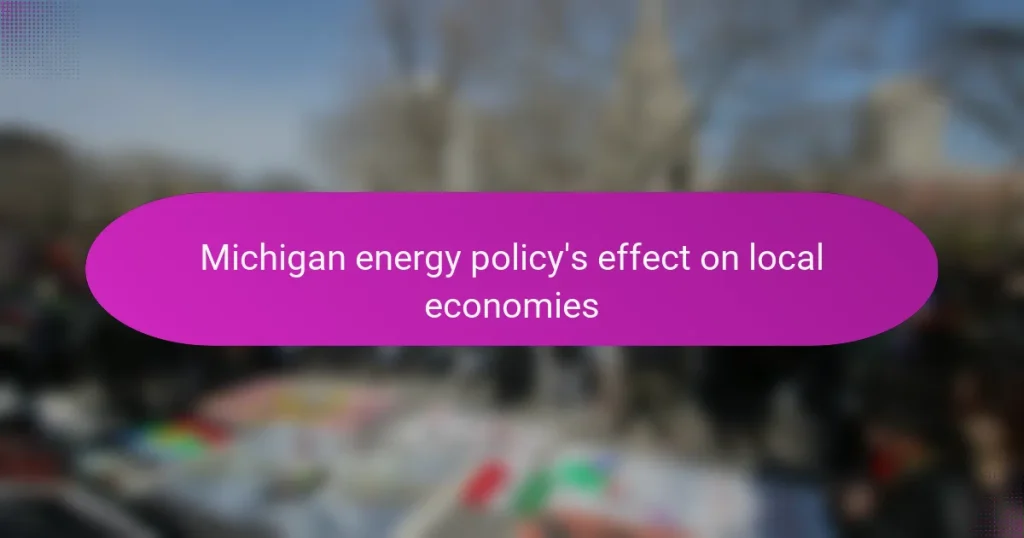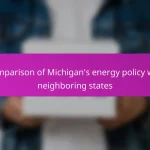
What is the impact of Michigan energy policy on local economies?
Michigan energy policy significantly impacts local economies by promoting renewable energy development. This policy encourages investment in clean energy sources, such as wind and solar. As a result, job creation in these sectors has increased. For instance, Michigan’s renewable energy sector employed over 100,000 people as of 2021. Additionally, local businesses benefit from lower energy costs due to increased energy efficiency initiatives. These initiatives often lead to reduced operational expenses for manufacturers and other industries. Furthermore, communities gain tax revenue from renewable energy projects, which can be reinvested in local services. Overall, Michigan’s energy policy fosters economic growth and sustainability at the local level.
How does Michigan energy policy influence economic growth?
Michigan energy policy promotes renewable energy sources and energy efficiency. This shift enhances job creation in the clean energy sector. In 2021, Michigan’s clean energy sector employed over 100,000 workers. The policy also incentivizes investments in energy infrastructure. Improved infrastructure attracts businesses and stimulates local economies. Additionally, energy efficiency programs lower utility costs for residents and businesses. Lower costs increase disposable income and spending. Overall, these factors contribute to sustained economic growth in Michigan.
What are the key components of Michigan’s energy policy?
Michigan’s energy policy includes several key components. These components focus on renewable energy standards, energy efficiency initiatives, and a commitment to reducing greenhouse gas emissions. The policy mandates that 15% of electricity must come from renewable sources by 2021. It also promotes energy efficiency programs that aim to reduce energy consumption across various sectors. Furthermore, Michigan’s energy policy emphasizes the importance of transitioning to cleaner energy sources to address climate change. This approach not only supports environmental sustainability but also aims to stimulate local economies by creating jobs in the renewable energy sector.
How do these components relate to local economic development?
Michigan energy policy components, such as renewable energy incentives and energy efficiency programs, directly influence local economic development. These components create job opportunities in renewable energy sectors. For example, the Michigan Renewable Energy Standard has led to the growth of solar and wind industries. According to the Michigan Energy Innovation Business Council, these industries have generated thousands of jobs. Additionally, energy efficiency programs reduce operational costs for local businesses. This cost reduction allows businesses to reinvest in their operations. Overall, Michigan’s energy policies foster economic growth by enhancing job creation and supporting local businesses.
What are the potential benefits of Michigan energy policy for local economies?
Michigan energy policy can stimulate local economies by promoting clean energy jobs. The transition to renewable energy sources creates employment opportunities in manufacturing, installation, and maintenance. For example, the Michigan Energy Innovation Business Council reported that the clean energy sector employed over 100,000 workers in 2020.
Additionally, energy efficiency programs reduce utility costs for businesses and households. Lower energy bills can increase disposable income, which stimulates local spending.
Moreover, investments in local energy projects can enhance community resilience. Localized energy generation minimizes reliance on external sources and can lead to economic stability.
Furthermore, Michigan’s commitment to renewable energy can attract new businesses. Companies often seek locations with sustainable energy practices, enhancing the state’s competitiveness.
In summary, Michigan energy policy benefits local economies through job creation, lower energy costs, community resilience, and business attraction.
Which sectors are expected to benefit the most from these policies?
The sectors expected to benefit the most from Michigan’s energy policies include renewable energy, manufacturing, and construction. Renewable energy is prioritized due to incentives for solar and wind projects. Manufacturing will see growth from increased demand for energy-efficient technologies. The construction sector will benefit from new projects related to energy infrastructure upgrades. These sectors align with the state’s goals for sustainability and job creation. The Michigan Energy Innovation Business Council reports that renewable energy jobs have increased significantly, indicating a positive trend for these sectors.
How does energy policy affect job creation in local communities?
Energy policy significantly influences job creation in local communities. Effective energy policies can stimulate investment in renewable energy projects. This investment often leads to the creation of new jobs in construction, maintenance, and operation. For example, the Michigan Energy Efficiency Program has generated thousands of jobs since its inception. Additionally, transitioning to renewable energy sources can create long-term employment opportunities. According to a report by the Michigan Energy Innovation Business Council, clean energy jobs in Michigan grew by 20% from 2015 to 2019. Local economies benefit from increased employment and associated spending. Thus, energy policies directly impact job creation and economic growth in communities.
What challenges do local economies face due to Michigan’s energy policy?
Local economies in Michigan face several challenges due to the state’s energy policy. The transition to renewable energy sources can lead to job losses in traditional energy sectors. Many workers in coal and natural gas industries may find limited opportunities for retraining. Additionally, increased energy costs can burden local businesses, affecting their competitiveness. Regulatory compliance can impose financial strains on smaller enterprises. Some communities may experience reduced tax revenues as energy production shifts. The uneven pace of energy transition can create disparities among regions. Local infrastructure may also struggle to adapt to new energy demands. These challenges highlight the complexities of transitioning to sustainable energy while maintaining economic stability.
What are the economic risks associated with energy transitions?
Energy transitions pose several economic risks, including job losses in traditional sectors. The shift from fossil fuels to renewable energy can lead to significant unemployment in coal, oil, and gas industries. For example, the U.S. Energy Information Administration reported that the coal industry lost over 50,000 jobs between 2011 and 2020 due to declining demand.
Investment risks are also prevalent during energy transitions. Transitioning to new technologies often requires substantial upfront capital. If these investments do not yield expected returns, financial stability for businesses can be compromised. According to the International Renewable Energy Agency, around $2 trillion is needed annually to meet global energy transition goals.
Additionally, energy price volatility can arise from transitions. As markets adjust to new energy sources, prices may fluctuate significantly. This unpredictability can affect both consumers and businesses, leading to economic instability.
Finally, regulatory changes can introduce risks. New policies may favor certain energy sources over others, impacting existing investments. For instance, Michigan’s energy policy changes can alter market dynamics, potentially disadvantaging traditional energy providers while benefiting renewables.
How do regulatory changes impact local businesses?
Regulatory changes impact local businesses by altering operational costs and compliance requirements. New regulations can increase expenses related to permits, licenses, and environmental standards. For instance, stricter energy regulations may require businesses to invest in energy-efficient technologies. This can lead to higher upfront costs but potential long-term savings.
Additionally, regulatory changes can affect market competition. If new regulations favor larger companies, small businesses may struggle to compete. In Michigan, energy policy shifts have prompted local businesses to adapt to new energy sources and efficiency standards.
The Michigan Public Service Commission reported that changes in energy regulations could lead to increased operational costs for small businesses by up to 15%. This illustrates the tangible impact regulatory changes can have on local business viability.
How does Michigan’s energy policy compare to other states?
Michigan’s energy policy emphasizes renewable energy and energy efficiency. The state has set a goal for 50% of its energy to come from renewable sources by 2030. This is more ambitious than many states. For example, California aims for 60% by 2030, while Texas focuses on deregulated markets with less emphasis on renewables. Michigan also mandates energy waste reduction, targeting a 1% annual reduction in energy usage. This requirement is stricter than in many states, promoting efficiency. The state’s renewable portfolio standard is also higher than the national average. In comparison, several states have no such mandates. Overall, Michigan’s energy policy is progressive, focusing on sustainability and efficiency.
What lessons can Michigan learn from other states’ energy policies?
Michigan can learn several lessons from other states’ energy policies. First, states like California have successfully implemented aggressive renewable energy standards. These standards have encouraged investment in solar and wind energy, leading to job creation. Second, states such as Texas have benefited from deregulated energy markets. This approach has increased competition and reduced energy costs for consumers. Third, Michigan can study the incentives offered by states like New York. These incentives promote energy efficiency upgrades, which can lower overall energy consumption. Additionally, states like Massachusetts focus on community solar initiatives. This allows residents to invest in solar energy collectively, expanding access to renewable resources. Lastly, Michigan should consider the importance of energy storage solutions highlighted by states like Hawaii. These solutions enhance grid reliability and support renewable energy integration. By analyzing these successful strategies, Michigan can tailor its energy policies to boost local economies effectively.
How do different state policies affect local economic outcomes?
Different state policies significantly influence local economic outcomes. For instance, Michigan’s energy policies promote renewable energy investments. These investments create jobs in local communities. They also stimulate economic growth through increased energy efficiency programs. Additionally, tax incentives for renewable energy projects attract businesses. This leads to higher local tax revenues. Studies show that states with strong renewable energy policies experience faster job growth in related sectors. Overall, effective state policies can enhance local economies by fostering sustainable development and job creation.
What role do local stakeholders play in shaping Michigan energy policy?
Local stakeholders play a crucial role in shaping Michigan energy policy. They include community members, local governments, and businesses. These stakeholders provide input on energy needs and priorities. Their feedback influences policy decisions and energy initiatives. Local stakeholders advocate for renewable energy sources and energy efficiency programs. They often collaborate with state agencies to develop energy strategies. Public forums and meetings allow stakeholders to voice concerns and suggestions. Research shows that community engagement leads to more effective energy policies. Engaging local stakeholders ensures that policies reflect the unique needs of Michigan’s diverse communities.
How can communities influence energy policy decisions?
Communities can influence energy policy decisions through organized advocacy, public participation, and local initiatives. They can form coalitions to represent their interests effectively. Public forums allow community members to voice concerns and suggestions. Local governments can enact policies that reflect community priorities. Grassroots movements can raise awareness about specific energy issues. Research indicates that community engagement leads to more sustainable energy policies. For example, the Michigan Energy Efficiency Program was shaped by local input. This demonstrates the power of community involvement in shaping effective energy policies.
What partnerships are essential for effective energy policy implementation?
Essential partnerships for effective energy policy implementation include collaboration between government agencies, private sector companies, and non-profit organizations. Government agencies provide regulatory frameworks and funding mechanisms. Private sector companies bring innovation and investment to energy projects. Non-profit organizations advocate for community interests and environmental sustainability. Academic institutions contribute research and data analysis to inform policy decisions. These collaborations enhance resource sharing and stakeholder engagement. They also ensure that diverse perspectives are considered in energy policy development. Effective partnerships lead to more comprehensive and adaptable energy strategies.
What are the best practices for local economies to adapt to Michigan’s energy policy?
Local economies can adapt to Michigan’s energy policy by investing in renewable energy sources. Transitioning to solar and wind energy can reduce reliance on fossil fuels. Collaborating with state agencies can provide access to financial incentives. Local governments should promote energy efficiency programs to lower consumption costs. Engaging community stakeholders can foster support for energy initiatives. Education on energy conservation can empower residents to make informed choices. Forming partnerships with local businesses can drive innovation in sustainable practices. Tracking progress with measurable goals ensures accountability and continuous improvement.
How can local businesses align with energy efficiency initiatives?
Local businesses can align with energy efficiency initiatives by adopting sustainable practices. They can implement energy-efficient technologies such as LED lighting and smart thermostats. These technologies reduce energy consumption and lower utility costs. Additionally, businesses can participate in local energy audits to identify areas for improvement. Engaging with community programs that offer incentives for energy efficiency can also be beneficial. For example, Michigan offers various rebates for energy-efficient upgrades. By aligning with these initiatives, local businesses can enhance their competitiveness and contribute to a sustainable economy.
What strategies can communities employ to leverage energy policy for economic growth?
Communities can leverage energy policy for economic growth by implementing renewable energy initiatives. These initiatives can attract investments and create jobs. For example, Michigan’s commitment to renewable energy has led to significant job creation in solar and wind sectors. Communities can also promote energy efficiency programs to reduce costs for local businesses. By incentivizing energy-saving measures, they can enhance competitiveness. Additionally, forming public-private partnerships can facilitate funding for energy projects. This collaboration can lead to innovative solutions and shared resources. Overall, strategic alignment with energy policy can foster sustainable economic development in local communities.
Michigan energy policy serves as the primary entity in this article, which examines its significant effects on local economies. The article highlights how the promotion of renewable energy sources, such as wind and solar, has led to job creation, lower energy costs, and increased tax revenues for communities. Key components of the policy, including renewable energy standards and energy efficiency initiatives, are discussed in relation to their impact on economic growth and local development. Additionally, the article addresses potential challenges and risks associated with the energy transition, as well as the role of local stakeholders in shaping policy outcomes. Overall, the analysis underscores the importance of Michigan’s energy policy in fostering sustainable economic development.


